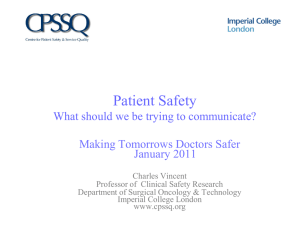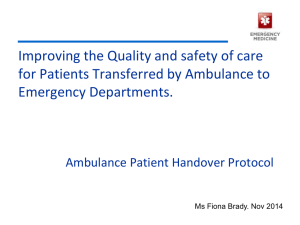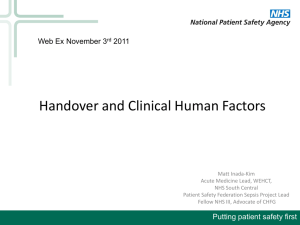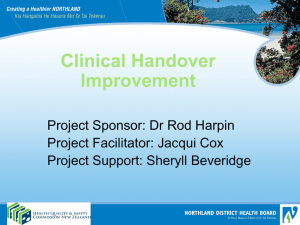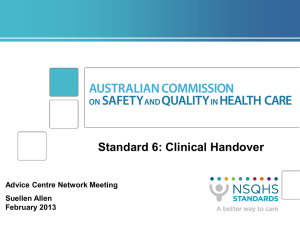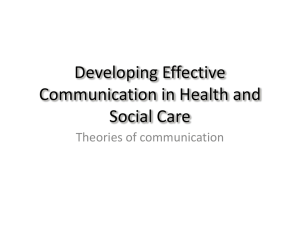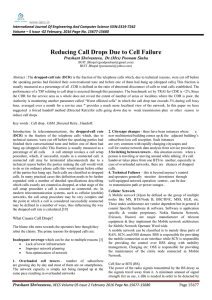The Impact of Anesthesia Handovers
advertisement
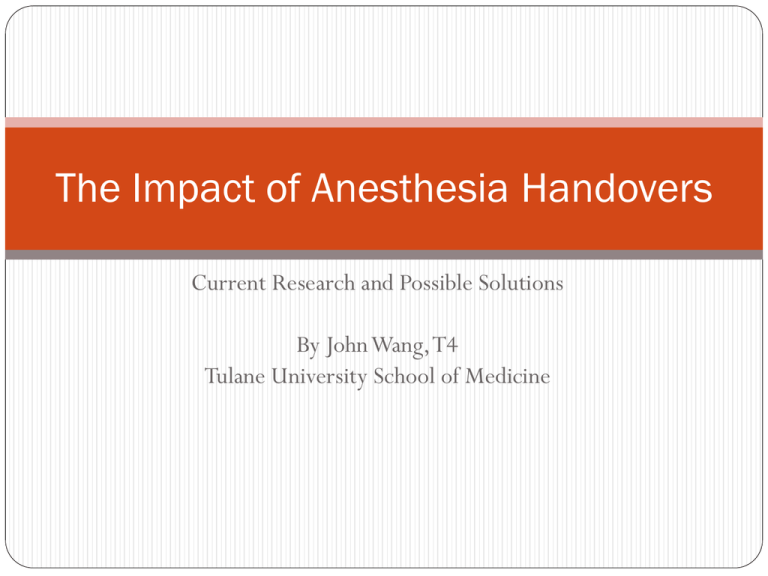
The Impact of Anesthesia Handovers Current Research and Possible Solutions By John Wang, T4 Tulane University School of Medicine 2011 annual meeting of the society of cardiovascular Anesthesiologists “The Impact of Anesthetic Handover on Mortality and Morbity in Cardiac Surgery.” Hudson c; Tran d; Dupuis J; McDonald B; Boodhwani M; Hudson J University of Owttawa Heart Institute, Ottawa, Ontario, Canada Patients passed from one anesthesiologist to another during cardiac surgery had a 2.2 times higher risk of dying in the hospital Patients who underwent handover also were 55% likelier to experience major morbidity, including heart attack and stroke Recent Patient Safety Literature Shown increasing agreement that effective patient handover is critical to patient safety Patient handover has been defined a research priority Handovers in the field of anesthesia is particularly important 3 Q’s that need to be addressed What is the current handover practice? What constitutes a handover that contributes to the quality and safety of patient care? How can clinicians be trained for and effectively supported during handover? Current Handover Practice Variable, unstructured and error prone Current Handover Practice Environmental Factors causes distraction Study done by Anwari JS. looking at handoffs between the anesthesiologists and postoperative recovery nurses 32.6% of anesthesiologists attained maximum scores for the quality of verbal information 40% involved preoperative status 36.6% involved premedication 20.7% involved operative details 15% involved intra-operative course and complications Anwari JS. Quality of handover to the postanaesthesia care unit nurse. Anaesthesia 2002; 57(5); 535-542 Criteria for handovers that contributes to the quality and safety of patient care Literature review of 400 relevant articles, led to the identification of seven primary functions for patient handoffs 1. 2. 3. 4. 5. 6. 7. Information processing Stereotypical narratives Resilience Accountability Social interaction Distributed cognition Cultural norms Patterson ES & Wears RL. Patient handoffs: standardized and reliable measurement tools remain elusive. Joint Commission Journal on Quality and Patient Safety 2010; 36(2): 52-61 Criteria for handovers that contributes to the quality and safety of patient care Literature review of 400 relevant articles, led to the identification of seven primary functions for patient handoffs Conclusion: 1. Diversity of handoff measurement approaches lack consensus about primary purpose of a handoff as well as promising interventions to improve handoff processes 2. Suggests that overall quality were predicted by 3 factors: Information transfer, shared understanding, and working atmosphere Patterson ES & Wears RL. Patient handoffs: standardized and reliable measurement tools remain elusive. Joint Commission Journal on Quality and Patient Safety 2010; 36(2): 52-61 Clinician Training in Handovers Currently, 56% of departments provide guidelines for patient transfers to intensive therapy units, and only 14% for handover of anesthetized patients. Horn J, Bell D & Moss E. Handover of responsibility for the anaesthetised patientopinion and practice. Anaesthesia 2004;59: 658-663 Standardized Protocol: Two Methods First approach: defines specific information content and order and generates handover protocols that are specific to the clinical setting. Standardized Protocol: Two Methods Second approach: general interaction structures that do not define the exact content, but the topics to be covered and their order Team Approach Patient handover is not just a one-way transfer of information Team Approach It’s involves shared cognition/shared decision making between health-care providers and an opportunity for collaborative cross-checking. Patterson E, Woods D, Cook R et al. Collaborative cross-checking to enhance resilience. Cognition,Technology &Work 2007; 9:155-162 2011 annual meeting of the society of cardiovascular Anesthesiologists “Pilot Implementation of a Perioperative protocol to Guide Operating Room-to-Cardiac ICU Patient Handoffs Petrovic M; Aboumatar H; Martinez E Massachusetts General Hospital, Boston, MA, USA; JohnHopkins University, Baltimore, MD, USA 1. Protocol introduced a Standardized, Structured, and reproducible approach 2. Key members of the team must be present during the handoff, including the surgeon, the anesthesiologist and the receiving nurse and clinician 3. Using discipline-specific checklists 2011 annual meeting of the society of cardiovascular Anesthesiologists “Pilot Implementation of a Perioperative protocol to Guide Operating Room- to-Cardiac ICU Patient Handoffs Petrovic M; Aboumatar H; Martinez E Massachusetts General Hospital, Boston, MA, USA; JohnHopkins University, Baltimore, MD, USA 1. Percentage of missed information in the surgery reports decreased from 26% to 16% (p=0.03) 2. Percentage of missed information in the anesthesia reports showed no significant change 19% to 17% (p>0.05) 3. ICU nurse satisfaction scores increased from 61% to 81% 4. Overall: perioperative handoff changed from noisy, multitasking process to an orderly, audible exchange of information among all team members Conclusions Handovers have shown to have a negative impact on patient outcomes Lack of formal training and formal systems in handoff situations Overall quality of handovers predicted by 3 factors: Information transfer, shared understanding, and work atmosphere Evidence that team based approach shows promise


